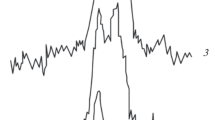Abstract
The properties and structure of films prepared from solutions of potassium silicate were studied by thermal analysis, IR spectroscopy, and X-ray diffraction. Various SiO2:K2O molar ratios from 2.55 to 4.72 were prepared and studied to determine the effect of molar ratio on the hygroscopic nature, solubility, and intumescence. The results provided insight into the physical structure, and mechanism of water absorption of the potassium silicate films. The molar ratio has a profound effect on the solubility, water absorption, and intumescence of the potassium silicate film. The primary mechanism of water absorption and retention is by ionic hydration. Decrease in the ionic hydration driving force as the molar ratio is increased results in decreasing solubility. Since intumescence results from the release of water vapour, the degree of intumescence decreases as the amount of ionically bonded water decreases with increase in molar ratio.
Similar content being viewed by others
References
E. M. Bulewicz, A. Pelc, R. Kozlowskt andA. Miciukiewicz,Fire Mater.9 (1985) 171.
D. Barby, J. A. R. Griffiths andD. Pawson, in “The Modern Inorganic Chemicals Industry”, edited by R. Thompson (Chemical Society, London, 1977) p. 320.
R. Iler, in “The Chemistry of Silica” (John Wiley, New York, 1977).
R. K. Harris, C. T. G. Knight andW. Hull,J. Amer. Chem. Soc.103 (1981) 1577.
J. Depasse andA. Watillon,J. Coll. Interface Sci.33 (1970) 430.
I. Shapiro andI. M. Kolthoff,J. Amer. Chem. Soc.72 (1950) 776.
R. K. Iler andR. L. Dalton,J. Phys. Chem.60 (1956) 955.
D. L. Wood, E. M. Rabinovich, D. W. Johnson, Jr., J. B. Macchesney andE. M. Vogel,J. Amer. Ceram. Soc.66 (1983) 693.
W. J. Moore, in “Physical Chemistry” (Prentice-Hall, Englewood Cliffs, N.J., 1972).
O. D. Kurilenk andV. V. Mank,Croatica Chemica Acta,48 (1976) 505.
G. J. Young andT. P. Bursh,J. Coll. Sci.15 (1960) 361.
R. S. Mcdonald,J. Phys. Chem.62 (1958) 1168.
ASTM STP 104 (American Society for Testing and Materials, Philadelphia, 1985).
ASTM STP 119 (American Society for Testing and Materials, Philadelphia, 1983)
M. L. Hair,J. Non-Cryst. Solids.19 (1975) 299.
S. A. Brawer andW. B. White,J. Chem. Phys.63 (1975) 2421.
M. Decottignies, J. Phalippou andJ. Zarzycki,J. Mater. Sci.13 (1978) 2605.
J. Wong andC. A. Angell,Appl. Spect. Rev.4 (1971) 155.
I. Simon, in “Modern Aspects of the Vitreous State” (Butterworths, London, 1960) p. 120.
R. Hanna,J. Amer. Ceram. Soc.48 (1965) 595.
N. P. Bansal,ibid.71 (1988) 666.
G. H. Sigel, Jr., in “Treatise on Materials Science and Technology”, Vol. 12 (Academic, New York, 1977) p. 60.
A. E. Van Arkel, in “Molecules and Crystals in Inorganic Chemistry” (Butterworths, London, 1949).
A. Blazek, in “Thermal Analysis” (Van Nostrand Reinhold, London, 1973) p. 200.
C. Duval, in “Inorganic Thermogravimetric Analysis”, 2nd edn (Elsevier, New York, 1963) p. 262.
JCPDS File No. 19-968, Powder Diffraction File, Inorganic, 1985 (JCPDS, International Center for Diffraction Data, Swarthmore, Pa, 1985).
JCPDS File No. 14-512, Powder Diffraction File, Inorganic, 1985 (JCPDS, International Center for Diffraction Data, Swarthmore, Pa, 1985).
“CRC Handbook of Chemistry and Physics”, 68th edn (CRC Boca, Raton, Florida, 1987).
R. Hanna andG. J. Su,J. Amer. Ceram. Soc.47 (1964) 597.
G. Su, N. F. Borrelli andA. R. Miller,Phys. Chem. Glasses3 (1962) 167.
Author information
Authors and Affiliations
Rights and permissions
About this article
Cite this article
Langille, K.B., Nguyen, D., Bernt, J.O. et al. Mechanism of dehydration and intumescence of soluble silicates. J Mater Sci 26, 695–703 (1991). https://doi.org/10.1007/BF00588306
Received:
Accepted:
Issue Date:
DOI: https://doi.org/10.1007/BF00588306




